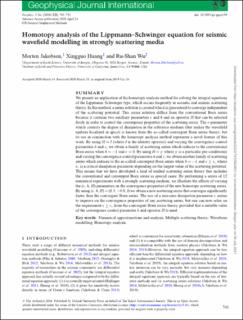| dc.contributor.author | Jakobsen, Morten | |
| dc.contributor.author | Huang, Xingguo | |
| dc.contributor.author | Wu, Ru-Shan | |
| dc.date.accessioned | 2020-04-27T12:18:45Z | |
| dc.date.available | 2020-04-27T12:18:45Z | |
| dc.date.issued | 2020 | |
| dc.Published | Jakobsen M, Huang X, Wu R. Homotopy analysis of the Lippmann-Schwinger equation for seismic wavefield modeling in strongly scattering media. Geophysical Journal International. 2020 | eng |
| dc.identifier.issn | 0956-540X | en_US |
| dc.identifier.issn | 1365-246X | en_US |
| dc.identifier.uri | https://hdl.handle.net/1956/22014 | |
| dc.description.abstract | We present an application of the homotopy analysis method for solving the integral equations of the Lippmann-Schwinger type, which occurs frequently in acoustic and seismic scattering theory. In this method, a series solution is created which is guaranteed to converge independent of the scattering potential. This series solution differs from the conventional Born series because it contains two auxiliary parameters ε and h and an operator H that can be selected freely in order to control the convergence properties of the scattering series. The ε-parameter which controls the degree of dissipation in the reference medium (that makes the wavefield updates localized in space) is known from the so-called convergent Born series theory; but its use in conjunction with the homotopy analysis method represents a novel feature of this work. By using H = I (where I is the identity operator) and varying the convergence control parameters h and ε, we obtain a family of scattering series which reduces to the conventional Born series when h = −1 and ε = 0. By using H = γ where γ is a particular preconditioner and varying the convergence control parameters h and ε, we obtain another family of scattering series which reduces to the so-called convergent Born series when h = −1 and ε ≥ εc where εc is a critical dissipation parameter depending on the largest value of the scattering potential. This means that we have developed a kind of unified scattering series theory that includes the conventional and convergent Born series as special cases. By performing a series of 12 numerical experiments with a strongly scattering medium, we illustrate the effects of varying the (ε, h, H)-parameters on the convergence properties of the new homotopy scattering series. By using (ε, h, H) = (0.5, −0.8, I) we obtain a new scattering series that converges significantly faster than the convergent Born series. The use of a non-zero dissipation parameter ε seems to improve on the convergence properties of any scattering series, but one can now relax on the requirement ε ≥ εc from the convergent Born series theory, provided that a suitable value of the convergence control parameter h and operator H is used. | en_US |
| dc.language.iso | eng | eng |
| dc.publisher | Oxford University Press | en_US |
| dc.rights | Navngivelse 4.0 Internasjonal | |
| dc.rights.uri | http://creativecommons.org/licenses/by/4.0/deed.no | |
| dc.title | Homotopy analysis of the Lippmann-Schwinger equation for seismic wavefield modeling in strongly scattering media | en_US |
| dc.type | Peer reviewed | |
| dc.type | Journal article | |
| dc.date.updated | 2020-02-12T08:43:53Z | |
| dc.description.version | publishedVersion | en_US |
| dc.rights.holder | Copyright the Author(s) 2020. Published by Oxford University Press on behalf of The Royal Astronomical Society. | en_US |
| dc.identifier.doi | https://doi.org/10.1093/gji/ggaa159 | |
| dc.identifier.cristin | 1777097 | |
| dc.source.journal | Geophysical Journal International | |
| dc.source.pagenumber | 743–753 | |
| dc.identifier.citation | Geophysical Journal International. 2020, 222 (2), 743-753. | |
| dc.source.volume | 222 | |
| dc.source.issue | 2 | |

